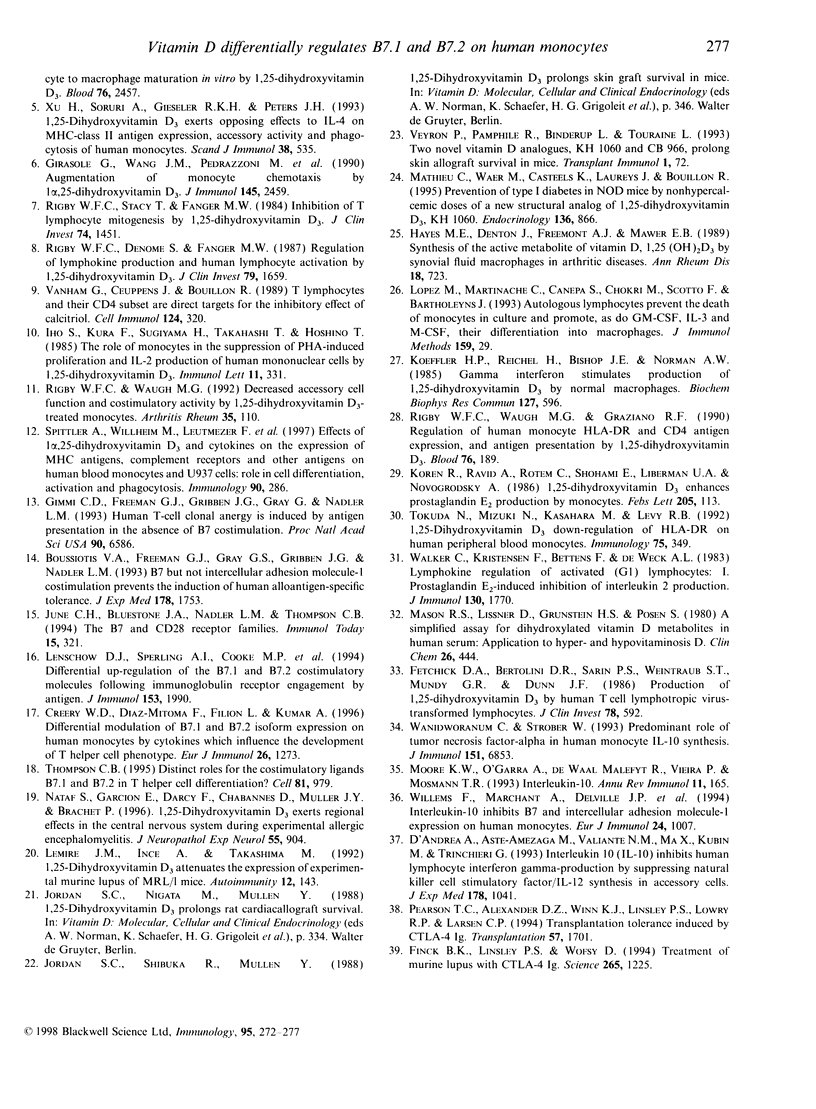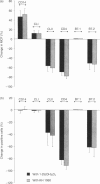Abstract
The hormonal active form of vitamin D3, 1,25-dihydroxyvitamin D3 (1, 25(OH)2D3), inhibits (through an unknown mechanism) the ability of monocytes/macrophages to induce T-cell activation. For T cells to be optimally activated, recognition of antigen/major histocompatibility complexes (MHC) by the T-cell receptor (TCR) must be accompanied by a second costimulatory signal. Considerable experimental data now suggest that this costimulatory signal is predominantly generated by B7.1 and/or B7.2 molecules, expressed on antigen-presenting cells (APC), when engaged to their counter-receptor, CD28, present on T cells. To determine whether the inhibitory effect of 1,25(OH)2D3 on monocytes/macrophages might involve modulation of the expression of B7.1 and B7.2 molecules, we analysed (by flow cytometry) the influence of 1,25(OH)2D3 and an analogue, KH 1060, on the expression of these two molecules at the surface of resting human peripheral blood monocytes. In parallel, we tested the effect of these two agents on human monocyte expression of cell-surface markers (CD14 and CD4) and antigen-presenting molecules (MHC class I and MHC class II). Our results showed that both 1,25(OH)2D3 and KH 1060 inhibited the basal expression of B7.2 in a dose- and time-dependent manner, without affecting B7.1. Moreover, these two compounds increased CD14 and reduced MHC class II and CD4 expression. Furthermore, the effect of 1,25(OH)2D3 on B7 molecule expression in combination with lipopolysaccharide (LPS) or cytokines, including interleukin-10 (IL-10), interferon-gamma (IFN-gamma) and tumour necrosis factor-alpha (TNF-alpha), was studied. The 1,25(OH)2D3-induced B7.2 down-regulation was still detectable when monocytes were activated by IL-10, IFN-gamma and TNF-alpha but not with LPS. Moreover, the induction of B7.1 by TNF-alpha was inhibited by addition of 1, 25(OH)2D3. We conclude that the ability of 1,25(OH)2D3 to decrease B7.2 expression on human monocytes might contribute to its inhibitory effect on APC-dependent T-cell activation and to its immunosuppressive properties observed in autoimmune diseases and organ transplantation.
Full text
PDF





Images in this article
Selected References
These references are in PubMed. This may not be the complete list of references from this article.
- Boussiotis V. A., Freeman G. J., Gray G., Gribben J., Nadler L. M. B7 but not intercellular adhesion molecule-1 costimulation prevents the induction of human alloantigen-specific tolerance. J Exp Med. 1993 Nov 1;178(5):1753–1763. doi: 10.1084/jem.178.5.1753. [DOI] [PMC free article] [PubMed] [Google Scholar]
- Casteels K., Bouillon R., Waer M., Mathieu C. Immunomodulatory effects of 1,25-dihydroxyvitamin D3. Curr Opin Nephrol Hypertens. 1995 Jul;4(4):313–318. doi: 10.1097/00041552-199507000-00005. [DOI] [PubMed] [Google Scholar]
- Creery W. D., Diaz-Mitoma F., Filion L., Kumar A. Differential modulation of B7-1 and B7-2 isoform expression on human monocytes by cytokines which influence the development of T helper cell phenotype. Eur J Immunol. 1996 Jun;26(6):1273–1277. doi: 10.1002/eji.1830260614. [DOI] [PubMed] [Google Scholar]
- D'Andrea A., Aste-Amezaga M., Valiante N. M., Ma X., Kubin M., Trinchieri G. Interleukin 10 (IL-10) inhibits human lymphocyte interferon gamma-production by suppressing natural killer cell stimulatory factor/IL-12 synthesis in accessory cells. J Exp Med. 1993 Sep 1;178(3):1041–1048. doi: 10.1084/jem.178.3.1041. [DOI] [PMC free article] [PubMed] [Google Scholar]
- Fetchick D. A., Bertolini D. R., Sarin P. S., Weintraub S. T., Mundy G. R., Dunn J. F. Production of 1,25-dihydroxyvitamin D3 by human T cell lymphotrophic virus-I-transformed lymphocytes. J Clin Invest. 1986 Aug;78(2):592–596. doi: 10.1172/JCI112614. [DOI] [PMC free article] [PubMed] [Google Scholar]
- Finck B. K., Linsley P. S., Wofsy D. Treatment of murine lupus with CTLA4Ig. Science. 1994 Aug 26;265(5176):1225–1227. doi: 10.1126/science.7520604. [DOI] [PubMed] [Google Scholar]
- Gimmi C. D., Freeman G. J., Gribben J. G., Gray G., Nadler L. M. Human T-cell clonal anergy is induced by antigen presentation in the absence of B7 costimulation. Proc Natl Acad Sci U S A. 1993 Jul 15;90(14):6586–6590. doi: 10.1073/pnas.90.14.6586. [DOI] [PMC free article] [PubMed] [Google Scholar]
- Girasole G., Wang J. M., Pedrazzoni M., Pioli G., Balotta C., Passeri M., Lazzarin A., Ridolfo A., Mantovani A. Augmentation of monocyte chemotaxis by 1 alpha,25-dihydroxyvitamin D3. Stimulation of defective migration of AIDS patients. J Immunol. 1990 Oct 15;145(8):2459–2464. [PubMed] [Google Scholar]
- Hayes M. E., Denton J., Freemont A. J., Mawer E. B. Synthesis of the active metabolite of vitamin D, 1,25(OH)2D3, by synovial fluid macrophages in arthritic diseases. Ann Rheum Dis. 1989 Sep;48(9):723–729. doi: 10.1136/ard.48.9.723. [DOI] [PMC free article] [PubMed] [Google Scholar]
- Iho S., Kura F., Sugiyama H., Takahashi T., Hoshino T. The role of monocytes in the suppression of PHA-induced proliferation and IL 2 production of human mononuclear cells by 1,25-dihydroxyvitamin D3. Immunol Lett. 1985;11(5-6):331–336. doi: 10.1016/0165-2478(85)90116-6. [DOI] [PubMed] [Google Scholar]
- June C. H., Bluestone J. A., Nadler L. M., Thompson C. B. The B7 and CD28 receptor families. Immunol Today. 1994 Jul;15(7):321–331. doi: 10.1016/0167-5699(94)90080-9. [DOI] [PubMed] [Google Scholar]
- Koeffler H. P., Reichel H., Bishop J. E., Norman A. W. gamma-Interferon stimulates production of 1,25-dihydroxyvitamin D3 by normal human macrophages. Biochem Biophys Res Commun. 1985 Mar 15;127(2):596–603. doi: 10.1016/s0006-291x(85)80202-3. [DOI] [PubMed] [Google Scholar]
- Koren R., Ravid A., Rotem C., Shohami E., Liberman U. A., Novogrodsky A. 1,25-Dihydroxyvitamin D3 enhances prostaglandin E2 production by monocytes. A mechanism which partially accounts for the antiproliferative effect of 1,25(OH)2D3 on lymphocytes. FEBS Lett. 1986 Sep 1;205(1):113–116. doi: 10.1016/0014-5793(86)80876-6. [DOI] [PubMed] [Google Scholar]
- Lemire J. M. Immunomodulatory actions of 1,25-dihydroxyvitamin D3. J Steroid Biochem Mol Biol. 1995 Jun;53(1-6):599–602. doi: 10.1016/0960-0760(95)00106-a. [DOI] [PubMed] [Google Scholar]
- Lemire J. M., Ince A., Takashima M. 1,25-Dihydroxyvitamin D3 attenuates the expression of experimental murine lupus of MRL/l mice. Autoimmunity. 1992;12(2):143–148. doi: 10.3109/08916939209150321. [DOI] [PubMed] [Google Scholar]
- Lenschow D. J., Sperling A. I., Cooke M. P., Freeman G., Rhee L., Decker D. C., Gray G., Nadler L. M., Goodnow C. C., Bluestone J. A. Differential up-regulation of the B7-1 and B7-2 costimulatory molecules after Ig receptor engagement by antigen. J Immunol. 1994 Sep 1;153(5):1990–1997. [PubMed] [Google Scholar]
- Lopez M., Martinache C., Canepa S., Chokri M., Scotto F., Bartholeyns J. Autologous lymphocytes prevent the death of monocytes in culture and promote, as do GM-CSF, IL-3 and M-CSF, their differentiation into macrophages. J Immunol Methods. 1993 Feb 26;159(1-2):29–38. doi: 10.1016/0022-1759(93)90138-w. [DOI] [PubMed] [Google Scholar]
- Mason R. S., Lissner D., Grunstein H. S., Posen S. A simplified assay for dihydroxylated vitamin D metabolites in human serum: application to hyper- and hypovitaminosis D. Clin Chem. 1980 Mar;26(3):444–450. [PubMed] [Google Scholar]
- Mathieu C., Waer M., Casteels K., Laureys J., Bouillon R. Prevention of type I diabetes in NOD mice by nonhypercalcemic doses of a new structural analog of 1,25-dihydroxyvitamin D3, KH1060. Endocrinology. 1995 Mar;136(3):866–872. doi: 10.1210/endo.136.3.7867594. [DOI] [PubMed] [Google Scholar]
- Moore K. W., O'Garra A., de Waal Malefyt R., Vieira P., Mosmann T. R. Interleukin-10. Annu Rev Immunol. 1993;11:165–190. doi: 10.1146/annurev.iy.11.040193.001121. [DOI] [PubMed] [Google Scholar]
- Nataf S., Garcion E., Darcy F., Chabannes D., Muller J. Y., Brachet P. 1,25 Dihydroxyvitamin D3 exerts regional effects in the central nervous system during experimental allergic encephalomyelitis. J Neuropathol Exp Neurol. 1996 Aug;55(8):904–914. doi: 10.1097/00005072-199608000-00006. [DOI] [PubMed] [Google Scholar]
- Pearson T. C., Alexander D. Z., Winn K. J., Linsley P. S., Lowry R. P., Larsen C. P. Transplantation tolerance induced by CTLA4-Ig. Transplantation. 1994 Jun 27;57(12):1701–1706. [PubMed] [Google Scholar]
- Provvedini D. M., Tsoukas C. D., Deftos L. J., Manolagas S. C. 1,25-dihydroxyvitamin D3 receptors in human leukocytes. Science. 1983 Sep 16;221(4616):1181–1183. doi: 10.1126/science.6310748. [DOI] [PubMed] [Google Scholar]
- Rigby W. F., Denome S., Fanger M. W. Regulation of lymphokine production and human T lymphocyte activation by 1,25-dihydroxyvitamin D3. Specific inhibition at the level of messenger RNA. J Clin Invest. 1987 Jun;79(6):1659–1664. doi: 10.1172/JCI113004. [DOI] [PMC free article] [PubMed] [Google Scholar]
- Rigby W. F., Stacy T., Fanger M. W. Inhibition of T lymphocyte mitogenesis by 1,25-dihydroxyvitamin D3 (calcitriol). J Clin Invest. 1984 Oct;74(4):1451–1455. doi: 10.1172/JCI111557. [DOI] [PMC free article] [PubMed] [Google Scholar]
- Rigby W. F., Waugh M. G. Decreased accessory cell function and costimulatory activity by 1,25-dihydroxyvitamin D3-treated monocytes. Arthritis Rheum. 1992 Jan;35(1):110–119. doi: 10.1002/art.1780350117. [DOI] [PubMed] [Google Scholar]
- Rigby W. F., Waugh M., Graziano R. F. Regulation of human monocyte HLA-DR and CD4 antigen expression, and antigen presentation by 1,25-dihydroxyvitamin D3. Blood. 1990 Jul 1;76(1):189–197. [PubMed] [Google Scholar]
- Spittler A., Willheim M., Leutmezer F., Ohler R., Krugluger W., Reissner C., Lucas T., Brodowicz T., Roth E., Boltz-Nitulescu G. Effects of 1 alpha,25-dihydroxyvitamin D3 and cytokines on the expression of MHC antigens, complement receptors and other antigens on human blood monocytes and U937 cells: role in cell differentiation, activation and phagocytosis. Immunology. 1997 Feb;90(2):286–293. doi: 10.1046/j.1365-2567.1997.00148.x. [DOI] [PMC free article] [PubMed] [Google Scholar]
- Thompson C. B. Distinct roles for the costimulatory ligands B7-1 and B7-2 in T helper cell differentiation? Cell. 1995 Jun 30;81(7):979–982. doi: 10.1016/s0092-8674(05)80001-7. [DOI] [PubMed] [Google Scholar]
- Tokuda N., Mizuki N., Kasahara M., Levy R. B. 1,25-Dihydroxyvitamin D3 down-regulation of HLA-DR on human peripheral blood monocytes. Immunology. 1992 Feb;75(2):349–354. [PMC free article] [PubMed] [Google Scholar]
- Vanham G., Ceuppens J. L., Bouillon R. T lymphocytes and their CD4 subset are direct targets for the inhibitory effect of calcitriol. Cell Immunol. 1989 Dec;124(2):320–333. doi: 10.1016/0008-8749(89)90134-2. [DOI] [PubMed] [Google Scholar]
- Walker C., Kristensen F., Bettens F., deWeck A. L. Lymphokine regulation of activated (G1) lymphocytes. I. Prostaglandin E2-induced inhibition of interleukin 2 production. J Immunol. 1983 Apr;130(4):1770–1773. [PubMed] [Google Scholar]
- Wanidworanun C., Strober W. Predominant role of tumor necrosis factor-alpha in human monocyte IL-10 synthesis. J Immunol. 1993 Dec 15;151(12):6853–6861. [PubMed] [Google Scholar]
- Willems F., Marchant A., Delville J. P., Gérard C., Delvaux A., Velu T., de Boer M., Goldman M. Interleukin-10 inhibits B7 and intercellular adhesion molecule-1 expression on human monocytes. Eur J Immunol. 1994 Apr;24(4):1007–1009. doi: 10.1002/eji.1830240435. [DOI] [PubMed] [Google Scholar]
- Xu H., Soruri A., Gieseler R. K., Peters J. H. 1,25-Dihydroxyvitamin D3 exerts opposing effects to IL-4 on MHC class-II antigen expression, accessory activity, and phagocytosis of human monocytes. Scand J Immunol. 1993 Dec;38(6):535–540. doi: 10.1111/j.1365-3083.1993.tb03237.x. [DOI] [PubMed] [Google Scholar]



